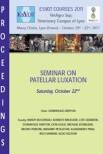Back problems are important contributors to poor performance in sport horses. It has been shown that kinematic analysis can differentiate horses with back problems from asymptomatic horses. The underlying mechanism can, however, only be identified in a uniform, experimental setting. Our aim was to determine if induction of back pain in a well-defined site would result in a consistent change in back movement. Back kinematics were recorded at a walk and trot on a treadmill. Unilateral back pain was then induced by injecting lactic acid into the left longissimus dorsi muscle. Additional measurements were done subsequent to the injections. Data were captured during steady state locomotion at 240 Hz using an infrared-based gait analysis system. After the injections, the caudal thoracic back was more extended at both gaits. The back was also bent more to the left at both gaits. However, at the walk, there was a reversed pattern after a week with bending of the back to the unaffected side. Horses with identical back injuries appear to show similar changes in their back kinematics, as compared to the asymptomatic condition. Unilateral back pain seems to result in an increased extension of the back, as well as compensatory lateral movements. Back movements are complex and subtle, and changes are difficult to detect with the human eye. Present-day gait analysis systems can identify changes in the back movement, and knowledge of the relationship between such changes and the site of injury will be of help in better localising and diagnosing disorders of the equine back.
Spinal kinematics in horses with induced back pain
Date
2009
Journal
Veterinary and Comparative Orthopaedics and Traumatology
Volume
6
Pages
448-454









